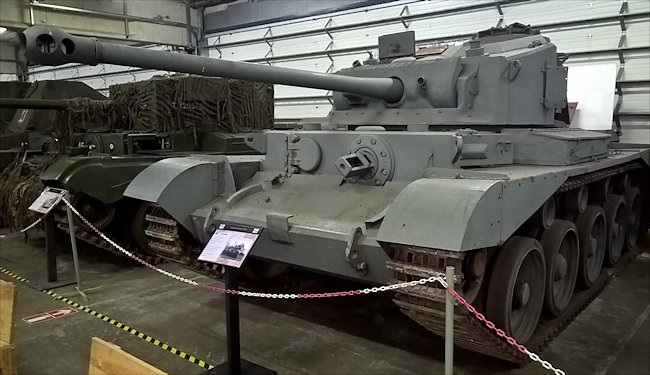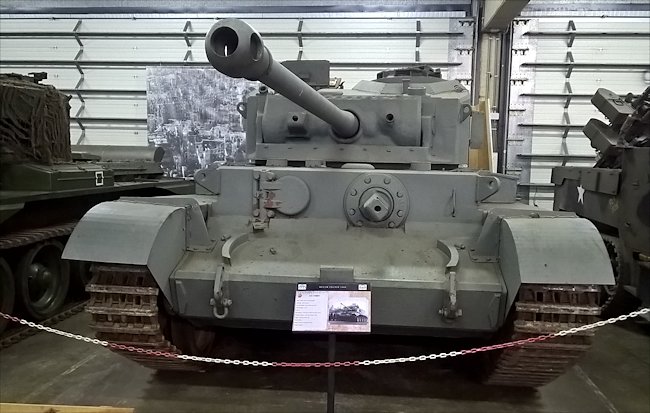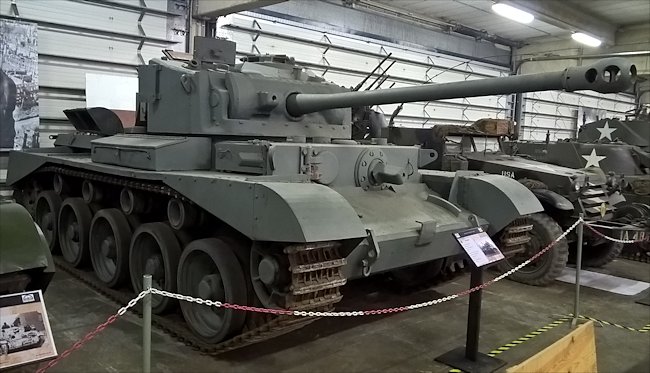British A34 Comet Tank
The British A34 Comet Tank was armed with the powerful 17pdr gun which was capable of engaging German panzers at longer range. Although some were delivered to the front line in December 1944 none saw action in the WW2 Battle of the Bulge. They went on to cross the Rhine and battle through Germany. This surviving A34 Comet Tank is kept at the Bastogne Barracks in Belgium.

This restored British A34 Comet Tank is exhibited at the Bastogne Barracks in Belgium.
Location
The Bastogne Barracks can be found at 40 Rue de la Roche (N834) in Bastogne just north west of the city centre. They open at 10am and close at 4pm. You really need to get there by 2pm as there is a lot to see. It is an operational military camp with a tank restoration centre attached. You have to wait to go on a guided tour. You cannot wander around on your own. The only day it is closed is Monday. Many of the tanks have been restored to running condition. Have a look at their Facebook page for information about new events.

This restored British A34 Comet Tank is exhibited at the Bastogne Barracks in Belgium.
Comet tanks were in Europe in December 1944
At the beginning of December 1944 units of the British 11th Armoured Division were put on reserve duties around Ypres while their tank crews started to refit with the new Comet tanks. When the German Ardennes offensive started, (the Battle of the Bulge) being one of few formations in reserve, the 11th Armoured Division was rushed back into to active service with its old, Sherman, Cromwell and Churchill tanks.
They were directed to hold a defensive line along the Meuse, between Namur and Givet. On Christmas Eve its advanced positions spotted and destroyed several tanks of the 2nd Panzer Division, east of Dinant. From 26 December onwards, the Germans started to withdraw and 11th Armoured was replaced by the 7th Airborne Division, after having pushed the enemy back beyond Celles. The 11th Armoured Division was called back to Ypres to restart the training of their tank crews on how to operate the new A34 Comet Tank and its big gun. They went on to cross the Rhine and invade Germany in their A34 Comets.

This restored British A34 Comet Tank is exhibited at the Bastogne Barracks in Belgium.
Specifications
The A34 Comet tank was powered by a Rover or Morris built Rolls-Royce Meteor Mk III V12 petrol engine that produced 600 hp. The the engine drove the rear sprockets through a five-speed Merritt-Brown combined gearbox and steering unit. The Comet was heavier than the Cromwell tank it was designed to replace. It had a combat weight up from 27 tons to around 33 tons. This meant that the top road speed of 32 mph (51 km/h) was slower than that of the Cromwell. It had an operating range of around 125 miles (202 km) before the crew needed to refuel. The tank was operated by a five-man crew: commander, driver, gunner loader and bow machine gunner.
The tank was armed with a 77 mm high velocity HV gun that used a shortened 17pdr gun barrel. It used the same calibre armour piercing projectile as the 17-pounder anti-tank gun, but the cartridge case was from the older QF 3 inch 20 cwt anti-aircraft gun loaded to higher pressures. This new British tank gun's ammunition was not interchangeable with the Sherman Firefly's 17-pounder, so to prevent confusion over ammunition supplies, it was renamed the 77 mm HV gun although it was the same 76.2 mm calibre as the 17-pounder. It could fire armour-piercing discarding sabot (APDS) shells that could penetrate 256 mm of armour plating at 500 metres and 233 mm at 1000 meters. It was a Tiger and Panther tank killer.
The Comet tank was also armed with two 7.92mm Besa machine guns. One was in the hull and another next to the main gun in the turret. Production started in September 1944 and the first batch were delivered to the European battlefront in December 1944. A total of 1,186 were produced.
The Development of the Comet Tank
Though Birmingham Carriage and Wagon were the original design and production 'parents' for the A27 (Centaur/Cromwell) series, production delays and difficulties in correcting mechanical deficiencies led to the parentage being transferred to Leylands in May 1943. The quest to upgun the Cromwell led to the development of the AY) Challenger with 17pdr gun, which, as had been noted, was not a satisfactory design.
When Leyland took over the A27, they immediately work on designing an improved version incorporating modifications to overcome the limitations of the A27 design. Mechanically and dimensionally the improved vehicle, designated A34, was similar to the A27. To avoid the need for widening the hull, as had been necessary in the A30 to take the 17pdr gun, Vickers-Armstrong designed a new compact version of the 17pdr with a shorter barrel, shorter breech, and lighter weight.
Known originally as the Vickers HV 75mm (H V: High Velocity), but later called the 77mm gun, it had a performance and penetrating power only slightly inferior to the 17pdr gun and fired the same ammunition.
It was intended that the 77mm gun would fit the original A27 type turret with only small modifications, but in the event an enlarged turret was found necessary. The A34 pilot model was ready for tests in February 1944, and among modifications incorporated as a result of trials was a stronger suspension with the addition of track return rollers.
By this time the A34 represented a 60% re-design of the A27 and was virtually a new tank. Production deliveries commenced in September 1944 and the first A34s, then named Comet, were issued to battalions of 11th Armoured Division after the Rhine crossing in March 1945, though a few vehicles were issued earlier, in December 1944.
The Comet proved a fast and reliable tank, the first British AFV to come near matching the German Panther in performance and gun power. However, it appeared too late to play any prominent part in British tank combat in World War Il. Comets subsequently equipped British armoured units post-war and some remained in service until the early sixties. Like the later marks of Cromwell, the Comet was of all-welded construction.
It could be distinguished from Cromwell by return rollers above road wheels. Welded turret with cast front, prominent cupola, and forward sloping roof. Prominent counterweight at turret rear. Late production vehicles had armoured fishtail exhausts and improved breathing system.
Read more in these two tank books

